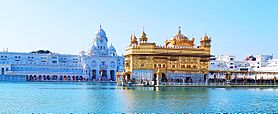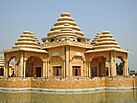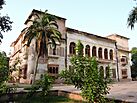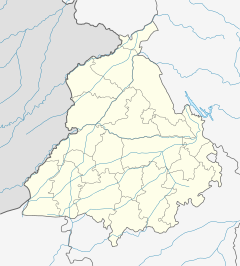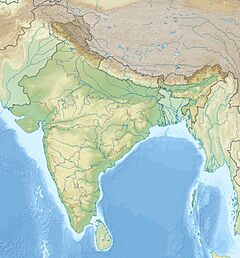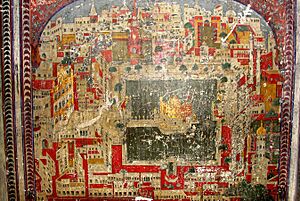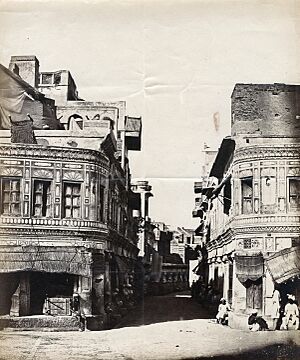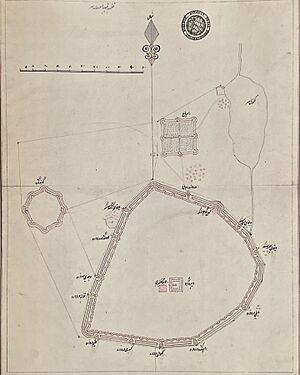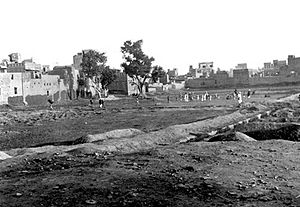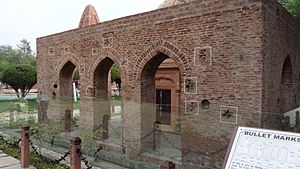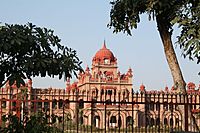Amritsar facts for kids
Quick facts for kids
Amritsar
Amr̥tasara
|
|
|---|---|
|
The Golden Temple
Gurdwara Baba Atal
Maharaja Ranjit Singh Chowk in Heritage Street
Bhagwan Valmiki Tirath Sthal
Ram Bagh Palace
Gobindgarh Fort
Partition Museum
|
|
| Nicknames:
Nicknames
The Holy City
Ambarsar Sifti Da Ghar Guru Nagari Golden City |
|
| Country | |
| State | |
| District | Amritsar |
| Founded by | Guru Ram Das |
| Government | |
| • Type | Municipality |
| • Body | Amritsar Municipal Corporation |
| Area | |
| • Total | 139 km2 (54 sq mi) |
| Area rank | 2nd in Punjab |
| Population
(2011)
|
|
| • Total | 1,159,227 |
| • Density | 8,340/km2 (21,600/sq mi) |
| • Metro rank | 44th |
| Demonym(s) | Amritsariya, Ambarsariya, Amritsari |
| Time zone | UTC+5:30 (IST) |
| PIN |
143-001
|
| Telephone code | 91 183 XXX XXXX |
| Vehicle registration | PB-01 (commercial vehicles), PB-02 |
Amritsar is a famous city in the Indian state of Punjab. It is the second-largest city in Punjab, after Ludhiana. Amritsar is a very important place for culture, travel, and business. It is the main city of the Amritsar district.
The city is about 217 kilometers (135 miles) north-west of Chandigarh. It is also about 455 kilometers (283 miles) north-west of New Delhi. Amritsar is very close to the India-Pakistan border, only 28 kilometers (17 miles) away.
In 2011, Amritsar had a population of over 1.1 million people. It is one of the ten biggest cities in Punjab. The city is known as the economic capital of Punjab. Many tourists visit Amritsar every day. It is also one of the special "heritage cities" chosen by the Indian government.
Amritsar is home to the Golden Temple. This is one of the most important and visited gurudwaras (Sikh temples) in the Sikh religion. The city is also famous for its delicious food and for making wooden chessboards and chess pieces.
Contents
Ancient Stories and Beliefs
The Bhagwan Valmiki Tirath Sthal in Amritsar is believed to be the home of Maharishi Valmiki. He was the writer of the ancient story Ramayana.
According to the Ramayana, Sita, the wife of Rama, gave birth to their sons, Lava and Kusha, at this place. Many people visit the Ramtirath Temple during its yearly fair. This temple is about 12 kilometers (7.5 miles) west of Amritsar.
It is also believed that the nearby cities of Lahore and Kasur were founded by Lava and Kusha. During a special ceremony by Rama, Lava and Kusha are said to have caught the ritual horse. They even tied Hanuman to a tree near where the Durgiana Temple stands today.
History of Amritsar
How Amritsar City Began
The city of Amritsar was founded by Guru Ram Das. He was the fourth Sikh guru. There are different stories about how he got the land. One story says the land was bought for 700 rupees from a village called Tung. This was done with money donated by Sikhs.
Another story from Sikh history says that Guru Amar Das, the third Sikh guru, chose the spot. He called it Guru Da Chakk. He asked Ram Das to find land for a new town and to build a special pool there.
After Guru Ram Das became guru in 1574, he started the town. It was named "Ramdaspur" after him. He first finished building the pool. Then he built his home and the main Guru center next to it. He invited traders and craftspeople from all over India to live in the new town.
The town grew bigger when Guru Arjan Dev was guru. This growth was paid for by donations and built by volunteers. The town eventually became the city of Amritsar. After Guru Arjan Dev built the gurdwara Harmandir Sahib, the pool area became a large temple complex. In 1604, the holy book of Sikhism was placed inside the new temple.
In the 1700s, the city faced attacks. In 1762 and again in 1766–1767, Ahmad Shah of the Durrani Empire attacked Amritsar. He destroyed parts of the city and harmed many people.
The Old Walled City
During the time of the Sikh Empire, Maharaja Ranjit Singh made the city stronger. In 1822, he started building a wall around the city.
He also built many fortified neighborhoods called Katras. These included Katra Moti Ram and Katra Ahluwalia.
Later, Sher Singh continued building the city wall. He added twelve gates around the city. He also built a fort called Dhoor Kot. The wall was about five miles long. Some of these gates still exist today, though some have been renamed.
When the British took control of Punjab in 1849, Amritsar was a walled city. The British added a thirteenth gate in 1866, called Hall Gate. They also rebuilt some parts of the wall. A new city wall was finished in 1885.
Jallianwala Bagh Massacre
A very sad event happened in Amritsar on April 13, 1919. This day was Vaisakhi, a holy day for Sikhs. Many unarmed Indian people had gathered peacefully in a garden called Jallianwala Bagh.
A British officer, Colonel Reginald Dyer, arrived with soldiers. Without warning, he ordered his troops to shoot into the crowd. The firing lasted for about ten minutes. Hundreds of people were killed, and many more were injured. This event is known as the Jallianwala Bagh massacre.
This tragedy caused a lot of anger and sadness across India. It became a very important moment in India's fight for independence from British rule.
Operation Blue Star
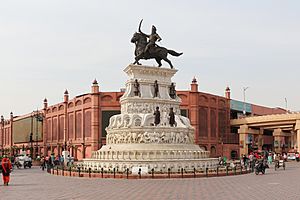
In the 1980s, Amritsar faced more challenges. Some Sikh militants took over the Golden Temple. To remove them, the Prime Minister of India, Indira Gandhi, ordered a military operation called Operation Blue Star. This happened from June 1 to June 6, 1984.
Indian army troops, using tanks, entered the temple complex. The operation was successful in removing the militants. However, it caused a lot of debate and controversy. Many people were killed, including soldiers, militants, and innocent visitors.
Four months later, on October 31, 1984, Indira Gandhi was killed by two of her Sikh bodyguards. This was seen as an act of revenge for Operation Blue Star. After her death, there were widespread riots in 1984 where many Sikhs were killed.
Amritsar's Location and Weather
Amritsar is located in the Majha region of Punjab, in North India. It is about 234 meters (768 feet) above sea level. The city is about 15 miles (24 kilometers) east of the border with Pakistan.
Climate and Seasons
Amritsar has a hot, semi-dry climate. It also gets some monsoon rains. Temperatures in Amritsar can range from below freezing in winter to very hot in summer.
The city has four main seasons:
- Winter: From December to March, temperatures can drop to -1°C (30°F).
- Summer: From April to June, temperatures can reach 45°C (113°F).
- Monsoon: From July to September, when it rains a lot.
- Post-monsoon: October to November.
Amritsar gets about 726 millimeters (28.6 inches) of rain each year. The lowest temperature ever recorded was -3.6°C (25.5°F) in 1996. The highest was 48.0°C (118.4°F) in 2013. Amritsar was also ranked as the 39th best "National Clean Air City" in India in 2024.
People and Religions
In 2011, Amritsar had a population of 1,159,227 people. About 10% of the population was under six years old. The city's literacy rate was high, at 83.81%.
Religions in Amritsar
| Religion in Amritsar City (2011) | ||||
|---|---|---|---|---|
| Religion | Percent | |||
| Hinduism | 49.36% | |||
| Sikhism | 48.00% | |||
| Christianity | 1.23% | |||
| Islam | 0.51% | |||
| Other or not stated | 0.90% | |||
According to the 2011 Census, Hinduism is the main religion in Amritsar, followed by 49.36% of the people. Sikhism is the second largest religion, followed by 48.00% of the people. Other religions like Christianity (1.23%) and Islam (0.51%) are also present.
Amritsar is considered the holiest city in Sikhism. About 30 million people visit it every year for religious reasons.
Languages Spoken
In 2011, most people in Amritsar (91.12%) spoke Punjabi as their first language. About 7.90% spoke Hindi.
Places to Visit in Amritsar
- Golden Temple and Heritage Street
- Durgiana Mandir and Bada Hanuman Mandir
- Mata Lal Devi Mandir, Model Town
- Shri Ram Tirath and Valmiki Tirath
- Shivala Bagh Bhaiyan
- Punjab State War Heroes' Memorial & Museum
- Sadda Pind
- Urban Haat Food Street
- Gobindgarh Fort
- Ram Bagh Palace and
- Maharaja Ranjit Singh Museum
- Wagah border
- Gurudwara Shaheed Ganj Sahib
- Partition Museum
- Jallianwala Bagh
- Pul Kanjri
- VR Ambarsar, Circular Road
- Mall of Amritsar, near Hyatt
- Jang-e-Azadi Memorial near Kartarpur, India
Amritsar is a popular place for tourists. Many people come to see its famous sights. The most well-known place is the Golden Temple, which is beautiful and peaceful.
Other important places to visit include:
- The Durgiana Temple, another important temple.
- The Jallianwala Bagh, a memorial park that reminds us of the tragic event that happened there.
- The Gobindgarh Fort, a historic fort with interesting shows.
- The Partition Museum, which tells the story of the partition of India.
- The Wagah border, where you can watch a special flag ceremony every evening.
Amritsar's Economy
Amritsar is the second-largest city and district in Punjab. It is also one of the fastest-growing cities. In the 1980s, the city was famous for its textile industry.
Even though there were challenges in the 1980s, Amritsar still has many textile mills. It is known for its warm pashmina shawls, woolen clothes, and blankets. The city is also famous for its handicrafts. The craft of the Thatheras of Jandiala Guru, who make metal utensils, is even recognized by UNESCO.
Tourism and hotels have become very important for Amritsar's economy. Many hotels and restaurants have opened to serve the large number of tourists. This has helped local shopkeepers and taxi drivers too.
Getting Around Amritsar
By Air
Amritsar has its own international airport, called Sri Guru Ram Das Ji International Airport. It has flights to other parts of India and to other countries. It is one of the busiest airports in India for international travel.
By Train
Amritsar Junction railway station is the main train station in the city. It is the busiest railway station in Punjab. The Indian Railways plans to make it a world-class station, like an international airport.
By Road
Amritsar is located on the historic Grand Trunk Road. This road connects many parts of India. New expressways are being built to make travel faster. For example, the Delhi–Amritsar–Katra Expressway will cut travel time from Amritsar to New Delhi to just 4 hours.
A ring road is also being built around Amritsar to help with traffic.
Amritsar MetroBus
Amritsar has a special bus service called the Amritsar Metrobus. It started in 2019. These are fully air-conditioned buses that connect many important places in the city.
Some places connected by the MetroBus include:
- The Golden Temple
- Jallianwala Bagh
- Guru Nanak Dev University
- Durgiana Temple
- Khalsa College
Partner Cities
Amritsar has special connections with other cities around the world. These are called "Sister Cities":
- Bakersfield, California, United States
- Sandwell, West Midlands, England, United Kingdom
- Thetford, Norfolk, England, United Kingdom
Schools and Colleges
Amritsar has many good schools and colleges. Some of them are:
- BBK DAV College for Women
- D.A.V College
- D.A.V Public School
- Delhi Public School
- Government Medical College
- Guru Nanak Dev University
- Khalsa College
- Indian Institute of Management
- Spring Dale Senior School
Hospitals and Medical Care
The city also has important medical facilities:
- Dr. Vidyasagar Institute of Mental Health, a government mental hospital.
- Government Medical College.
- Sri Guru Ram Das University of Health Sciences.
See also
 In Spanish: Amritsar para niños
In Spanish: Amritsar para niños


